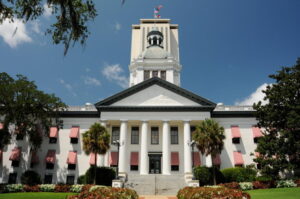
By Lina Alfieri Stern, MBA, MSRED, LEED Green Associate
As evidenced by new funding streams, strengthening the U.S. electrical grid is a national priority. United States Secretary of Energy Jennifer Granholm announced in October that $3.46 billion will be allocated to 58 projects across 44 states to support electric grid strengthening.
This funding, part of the Bipartisan Infrastructure Law, aims to enhance the resilience and reliability of the electric grid. The investment will bring more than 35 gigawatts of new renewable energy online and also support the development of 400 microgrids.
According to the U.S. Department of Energy, this funding marks the largest-ever direct investment in critical grid infrastructure and is the first round of selections under the broader $10.5 billion Grid Resilience and Innovation Partnerships (GRIP) Program managed by the Department of Energy’s Grid Deployment Office. And Florida is benefitting from a portion of the funding.
Gulf Coast states have been grappling with the aftermath of destructive hurricanes that have exposed vulnerabilities in their electric grids, prompting officials to seek solutions for fortifying and enhancing grid resilience. In their search for a model to emulate, many are turning to Florida, which has made significant improvements to its electric grid in recent years, showcasing the benefits of proactive measures in enhancing grid reliability and sustainability.
Florida serves as a prime example of collaborative efforts between different utility providers to enhance grid reliability and sustainability. By prioritizing grid modernization and investing in clean energy infrastructure, states can mitigate the impacts of extreme weather events, ensure reliable electricity supply, and create a more sustainable future for their residents and businesses.
Florida has been making investments in its electric grid for years. A notable initiative that exemplifies the state’s commitment to grid resilience and sustainability is the North Florida Resiliency Connection. Developed by Florida Power & Light, this state-of-the-art transmission line stretches 176 miles and aims to improve the grid’s resilience while accommodating renewable energy resources. The North Florida Resiliency Connection strengthens the electric grid and promotes the integration of clean energy sources, reducing carbon emissions and supporting sustainable development.
And federal funding will enhance Florida’s system.
The Fort Pierce Utilities Authority (FPUA) was awarded a grant of $5.8 million in this most recent round of funding by the GRIP program. This funding will enable FPUA to enhance resilience and modernize the Fort Pierce electric grid.
FPUA’s grant-funded projects include upgrading substation transformers to meet growing electric demand, replacing distribution transformers for modernization, upgrading a substation to a ring bus configuration for improved automation, and installing mounted reclosers to reduce outage frequency and duration. These initiatives enable FPUA to provide reliable electric service, even during unexpected outages, extreme weather events, and natural disasters.
“FPUA is incredibly proud to bring this support and funding to our community,” said Javier Cisneros, FPUA Director of Utilities. “These projects empower FPUA to maintain reliable electric service while reducing impacts on the grid caused by unexpected outages, extreme weather, and natural disasters. This project also represents tremendous effort by our electric and grant writing teams to build more resilient and sustainable infrastructure for Fort Pierce with support from grant funding.”
Other projects led by FPUA include relocating a sewer treatment plant off the Indian River Lagoon, lining sewer pipes with PVC to protect against cracks in aging clay pipes, and installing seagrass to promote environmental resilience. These initiatives demonstrate a comprehensive strategy to strengthen critical infrastructure and build a more resilient community.
Lake Worth will receive $23.4 million in grant funding for a system hardening and reliability project, designed to reduce vulnerability from extreme weather by installing more than 60 reclosers and sectionalizing devices to rebalance the electrical system, installing solar, and building new connections to enhance grid integrity.
Florida Power & Light will receive $30.3 million to install fault locators and manhole monitors in more than 600 vaults and 800 manholes to help identify outages more quickly, particularly during extreme weather events. The smart grid enhancements are also designed to extend the life of key equipment.
As Gulf States face the daunting task of rebuilding and fortifying their electric grids after devastating hurricanes, it can draw valuable lessons from Florida’s experiences. By investing in grid modernization, storm hardening, and the integration of renewable energy sources, localities can enhance the reliability, resilience, and sustainability of their electric grid.
Examples of ways to strengthen the electrical grid:
- Grid modernization: Upgrading and replacing aging infrastructure with advanced technologies, such as smart meters, sensors, and automation systems, to enhance grid reliability and efficiency.
- Increased transmission capacity: Building new transmission lines or upgrading existing ones to improve the flow of electricity across different regions, reducing congestion and enhancing grid stability.
- Distributed energy resources (DERs): Integrating distributed energy resources like solar panels, wind turbines, and energy storage systems into the grid, which can increase resiliency and reduce strain on centralized power plants.
- Microgrids: Establishing smaller-scale independent grids that can operate autonomously or in conjunction with the main grid, providing localized power during outages or emergencies.
- Demand response programs: Implementing initiatives that encourage consumers to adjust their electricity usage during peak demand periods, helping to balance supply and demand on the grid.
- Grid cybersecurity: Strengthening security measures to protect the grid from cyber threats and ensuring the integrity and reliability of the electrical infrastructure.
- Grid energy storage: Deploying large-scale energy storage technologies, such as batteries or pumped hydro storage, to store excess electricity during times of low demand and release it during peak periods, promoting grid stability.
Did You Know?
The state of Florida’s electric service is provided by a mix of investor-owned electric companies, municipally owned electric companies, and rural electric cooperatives.
Investor-owned electric companies are regulated by the Florida Public Service Commission to ensure fair rates and reliable service
Municipal electric utilities, owned and operated by municipalities within their boundaries, are regulated by their respective city commissions.
Rural electric cooperatives are regulated by elected cooperative officers and are financed by the Rural Electrification Association, supplying electric energy to specific areas, particularly rural regions.





















